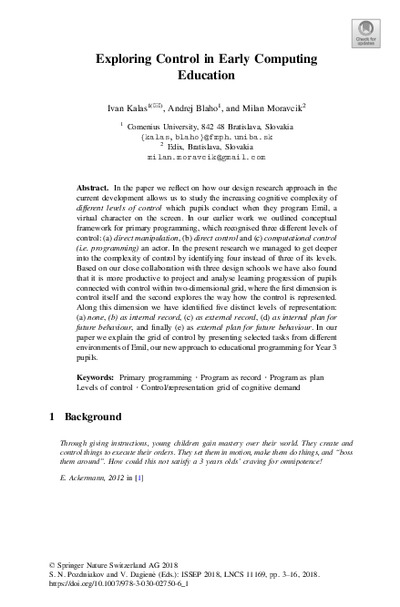Exploring Control in Early Computing EducationZu finden in: Informatics in Schools: Fundamentals of Computer Science and Software Engineering (Seite 3 bis 16), 2018
  |
 |
 Diese Seite wurde seit 1 Jahr inhaltlich nicht mehr aktualisiert.
Unter Umständen ist sie nicht mehr aktuell.
Diese Seite wurde seit 1 Jahr inhaltlich nicht mehr aktualisiert.
Unter Umständen ist sie nicht mehr aktuell.
 Zusammenfassungen
Zusammenfassungen
 In the paper we reflect on how our design research approach in the current development allows us to study the increasing cognitive complexity of different levels of control which pupils conduct when they program Emil, a virtual character on the screen. In our earlier work we outlined conceptual framework for primary programming, which recognised three different levels of control: (a) direct manipulation, (b) direct control and (c) computational control (i.e. programming) an actor. In the present research we managed to get deeper into the complexity of control by identifying four instead of three of its levels. Based on our close collaboration with three design schools we have also found that it is more productive to project and analyse learning progression of pupils connected with control within two-dimensional grid, where the first dimension is control itself and the second explores the way how the control is represented. Along this dimension we have identified five distinct levels of representation: (a) none, (b) as internal record, (c) as external record, (d) as internal plan for future behaviour, and finally (e) as external plan for future behaviour. In our paper we explain the grid of control by presenting selected tasks from different environments of Emil, our new approach to educational programming for Year 3 pupils.
In the paper we reflect on how our design research approach in the current development allows us to study the increasing cognitive complexity of different levels of control which pupils conduct when they program Emil, a virtual character on the screen. In our earlier work we outlined conceptual framework for primary programming, which recognised three different levels of control: (a) direct manipulation, (b) direct control and (c) computational control (i.e. programming) an actor. In the present research we managed to get deeper into the complexity of control by identifying four instead of three of its levels. Based on our close collaboration with three design schools we have also found that it is more productive to project and analyse learning progression of pupils connected with control within two-dimensional grid, where the first dimension is control itself and the second explores the way how the control is represented. Along this dimension we have identified five distinct levels of representation: (a) none, (b) as internal record, (c) as external record, (d) as internal plan for future behaviour, and finally (e) as external plan for future behaviour. In our paper we explain the grid of control by presenting selected tasks from different environments of Emil, our new approach to educational programming for Year 3 pupils. Dieser wissenschaftliche Zeitschriftenartikel erwähnt ...
Dieser wissenschaftliche Zeitschriftenartikel erwähnt ...
 Personen KB IB clear | Laura Benton , Ivan Kalas , Seymour Papert , Ben Shneiderman | ||||||||||||||||||||||||||||||||||||
 Begriffe KB IB clear |  Lernen Lernen learning
, learning
,  Programmieren Programmieren programming programming
| ||||||||||||||||||||||||||||||||||||
 Bücher |
| ||||||||||||||||||||||||||||||||||||
 Texte |
|
 Zitationsgraph
Zitationsgraph
 Zitationsgraph (Beta-Test mit vis.js)
Zitationsgraph (Beta-Test mit vis.js)
 2 Erwähnungen
2 Erwähnungen 
- Informatics in Schools. New Ideas in School Informatics (Sergei Pozdniakov, Valentina Dagienė) (2019)


- Observing Abstraction in Young Children Solving Algorithmic Tasks (Hylke H. Faber, Josina I. Koning, Menno D. M. Wierdsma, Henderien W. Steenbeek, Erik Barendsen)


- Observing Abstraction in Young Children Solving Algorithmic Tasks (Hylke H. Faber, Josina I. Koning, Menno D. M. Wierdsma, Henderien W. Steenbeek, Erik Barendsen)
- Informatics in Schools. Rethinking Computing Education - 14th International Conference on Informatics in Schools: Situation, Evolution, and Perspectives, ISSEP 2021, Virtual Event, November 3–5, 2021 (Erik Barendsen, Christos Chytas) (2021)


- Encouraging Task Creation Among Programming Teachers in Primary Schools (Jacqueline Staub, Zaheer Chothia, Larissa Schrempp, Pascal Wacker)


- Encouraging Task Creation Among Programming Teachers in Primary Schools (Jacqueline Staub, Zaheer Chothia, Larissa Schrempp, Pascal Wacker)
 Anderswo finden
Anderswo finden
 Volltext dieses Dokuments
Volltext dieses Dokuments
 |  Exploring Control in Early Computing Education: Artikel als Volltext @ Springer ( Exploring Control in Early Computing Education: Artikel als Volltext @ Springer ( : :  , 2003 kByte; , 2003 kByte;  : :  ) ) |
 Anderswo suchen
Anderswo suchen 
 Beat und dieser wissenschaftliche Zeitschriftenartikel
Beat und dieser wissenschaftliche Zeitschriftenartikel
Beat hat Dieser wissenschaftliche Zeitschriftenartikel während seiner Zeit am Institut für Medien und Schule (IMS) ins Biblionetz aufgenommen. Beat besitzt kein physisches, aber ein digitales Exemplar. Eine digitale Version ist auf dem Internet verfügbar (s.o.). Aufgrund der wenigen Einträge im Biblionetz scheint er es nicht wirklich gelesen zu haben. Es gibt bisher auch nur wenige Objekte im Biblionetz, die dieses Werk zitieren.













 Biblionetz-History
Biblionetz-History